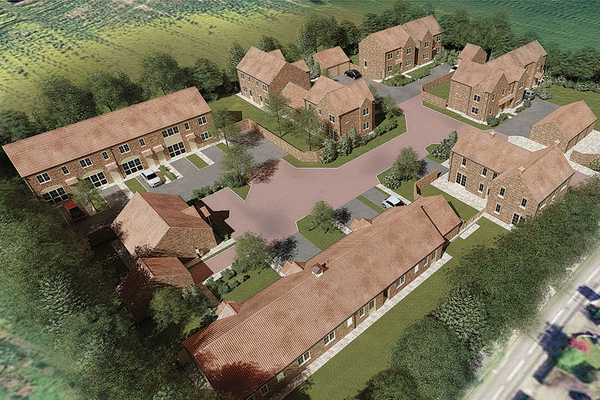The price of countryside living: how can it become more affordable?
Rural areas are more unaffordable than cities. Mark Deas looks at how to address the problem. Picture: Getty
Article written by:

The government has set targets to deliver 300,000 new homes a year but how many of these will be in rural communities? More importantly, how many will be tailored to the needs of rural communities?
Costly exodus
Rural communities are changing. They are getting older and they are becoming more dormitory in nature. The urban-rural shift continues as urban workers, retirees and owners of second homes are attracted to a more idyllic lifestyle.
The resulting pressure on rural housing markets has seen prices increase beyond the reach of many locals. According to the Department for Environment, Food & Rural Affairs’ March statistical digest, the average lower-quartile house price has risen to 9.1 the average lower-quartile income in mainly rural areas, compared with 7.4 in predominantly urban areas (excluding London).
To put that in context, I recently undertook a survey of housing needs in a small parish in South Cambridgeshire, where four out of the five houses sold in the past year had achieved prices in excess of £1m. The exodus of younger, economically active people and households that results from this distortion of the market has consequences for the community left behind. Social and support networks break down, especially for those who depend on multi-generational family members living in the community.
The safety net of affordable housing is disappearing. Since the introduction of the Right to Buy (RTB) in 1980 through to 2011, the percentage of rural housing stock owned by housing associations and local authorities fell from 24% to 8%. Increased discounts resulted in RTB sales quadrupling between 2012 and 2015, with only one replacement created for every eight sold. This trend is not showing any signs of reversing.
Of course, none of this is new – these arguments have been repeated countless times. The Hastoe-sponsored report Affordable Housing: A Fair Deal For Rural Communities has one of the more recent and robust analyses of rural housing issues.
What is so frustrating is that despite the plentiful supply of evidence about what actually works, recent government policy is exacerbating these issues.
The loss of rural affordable housing through RTB sales – and the threat of further sales through the Voluntary RTB being extended to housing associations – is being compounded by changes in planning policy. The removal of affordable housing contributions from schemes of fewer than 10 dwellings is having a disproportionate effect on rural communities. Even the most basic rural-proofing should have seen that one coming.
The National Planning Policy Framework (NPPF) has increased rural housing delivery through its “presumption in favour of sustainable development”. However, all too often this has been through schemes that simply bolt executive housing estates onto rural communities with little thought to their needs. In my experience, the communities almost always oppose schemes.
Few tools to use
Neighbourhood planning was introduced to give communities a bigger say in how their village should grow. But the NPPF’s Housing Delivery Test and five-year housing land supply rules mean they are constantly at risk of being undermined.
The experience in Cambridgeshire is that communities use neighbourhood plans as a defensive mechanism.
Very few seek to allocate significant sites for housing; instead, they recognise they are going to get housing whether they want it or not, but a neighbourhood plan gives them a chance to influence the nature and location of development, and hopefully, secure some investment in much-needed infrastructure improvements.
This picture appears to be consistent with the national trend, according to research by the planning and development consultancy Lichfields.
If neighbourhood planning only offers limited opportunities for rural communities to control the scale of housing development and national planning policy continues to refuse to flex to meet the evolving needs of rural communities, what other tools are available to those working at the coal face of rural affordable housing?
Rural Housing Enablers (RHEs) have been grappling with these issues since the 1990s. Our numbers have been steadily falling, but we remain a key source of local knowledge. Our staple product has been the rural exception site: small affordable housing schemes on the edge of villages with controls that ensure affordability in perpetuity and prioritise local people.
In Cambridgeshire, we have delivered more than 300 affordable homes for local people in rural communities on 26 schemes in the past six years. The county now has more than 1,000 affordable homes on rural exception sites.
However, they will only ever be part of the solution. The government’s enthusiasm for community-led housing (CLH) is encouraging and enabling hubs are being set up, often alongside RHEs, to support new forms of community-supported housing such as community land trusts. But what RHEs and CLH advisors need is more stability in funding and policy.
Which brings me back to the role of national policy. The government could reintroduce a rural investment programme with a rural multiplier for grant rates. It could ensure the new Homes England strategic partnerships deliver rural housing. It could stop “best consideration” and charity laws from being used to prevent landowners bringing sites forward at a viable price for affordable housing. It could introduce a statutory definition of affordable housing based on incomes – all too often, affordable housing isn’t affordable.
Finally, affordable housing needs to be affordable in the long term for tenants, and that means it must be energy efficient. A predominance of older stock, coupled with a lack of mains gas, means fuel poverty is much more significant in rural communities – 14% of households in villages and hamlets in England experience fuel poverty, compared with the average of 11%.
Climate change simply adds to the importance of this agenda. There are many examples of innovative practice, including ‘Passivhaus’, straw bales and other techniques. But although such approaches tend to win community support, they inevitably cost more, especially on small schemes where there is no economy of scale. Until such approaches become mainstream, schemes delivering above-standard energy efficiency will need bigger grants or lower land values.
However, it is important smaller villages and hamlets are not seen as ‘no-build’ areas because they are deemed unsustainable.
Too often rural affordable housing, especially schemes ‘off the grid’, is measured in terms of higher build costs. Instead, it should be measured in terms of the wider contribution it makes to the sustainability of rural communities and the economic returns this delivers.
Mark Deas, rural housing, planning and economic development officer, Cambridgeshire ACRE










